C.S.M. Ernest William Fereday
Army Service No. 5334942
ERNEST WILLIAM FEREDAY
28TH MARCH 1916 - 24TH OCTOBER 1995
....I cannot
in all honesty do justice in relaying the remarkable Army career of Ernest
William Fereday contributed to the Veterans Website Project by his daughter
Lynne on behalf of her sister and families. I have however removed all
personal details due to the nature of the world we now live in. Please
Note: Not all of the pictures from his album have been included
as there are considerably more.
....Ernest William Fereday was actually born...
but was probably better known as Ernie Fereday. His father was Gerald
Ernest Fereday... Gerald joined the army at the outbreak of the First
World War at the age of 16. He served in the ROYAL WELSH FUSILIERS throughout
the war and received several medals 1914-1915 and 1914-1918 and Great
War for Civilization 1914-1919. We believe he was demobbed in 1919. During
the war Gerald got married... In 1921 Jesse caught influenza and died,
she was only 24. Ernie, who was only 3 at the time, was then sent to live
with Gerald's foster sister... in Huntingdon in East Anglia. Ernie joined
the army in 1934 - THE ROYAL BERKSHIRE REGIMENT - it was his life. In
this album there is recorded part of his and our history during the war,
photographs of his friends and colleagues in the army, some who never
came back. Quite a few of them are named, others, Ernie unfortunately
could not remember. The story is now being told by Ernie's own words:
The first picture is of me when I had some leave and joined my foster
parents at Bognor. I went down in uniform as such, scruffy looking herb
there! Next photograph [LS02-2] is of three of us looking out of the Barrack
room window, taken by the camp photographer. Looking at the photograph,
a chap named O'Mara is on the right, who was a special mate of mine, Oshea
in the centre and I am on the left with a bit of hair over my eyes. The
photo on the far right I think is a chap called Barnes but not too sure.
Bottom left is O'Mara again and the next photograph [LS02-5] is of a few
troops in the same squad at the Depot there were 35 in all. My position
is 2nd along of the 3rd rank, with hat tilted right to the rear, Scruffy!
Top left, [LS04-1] this shows the Battalion marching down to Hythe Camp
with the drums and pipes, not the full band. I am in amongst them somewhere.
We march to Hythe which was 3 or 4 miles, stayed in camp there and fired
our annual course with rifles and if we qualified we could earn 3d (old
money a day extra for a marksman. Fortunately I qualified so I had a bit
more money. That was in 1935. The photographs on the top right and bottom
left are the transport chaps, in those days there were no mechanical transport,
just horses. Those men employed on transport were dressed like cavalrymen.
They had the Bandoliers and breeches and special Lanyard, which was different
dress to what we wore. The guy with the horse was Watts. The photograph
bottom right [LS04-4] is similar to the one above but there in an ink
arrow that was pointing to me. I expect you will wonder how I knew that
was me but I had good eyesight in those days and I knew who was in front
and who was in the rear. This photo I sent home.
Top left, [LS06-1] is the Depot of the Royal Berkshire Regiment, when
I joined, called 'Brock Barracks'. I took that with a Kodak pocket camera.
The bottom photograph [LS06-3] was taken two years before my time in 1932
when the 2nd Battalion moved into Camp. That lorry [LS06-2] behind the
marching troops has no windscreen just tarpaulin stretched across the
front and solid tyres. That was the old fashioned lorry for those days.
The next photograph is another of the Depot. I often wondered who that
chap was, wandering in the front.
These photographs [LS08-2 & 3] were all taken at Hythe Camp. Top left,
these were good chaps there was one from the North and one from the South
of Ireland. There is one who looks like Laurel of Laurel and Hardy fame;
in fact he used to do that very trick that Laurel did when he was puzzled
or upset. He would scratch his head and look just Laurel. He was always
known as Laurel. The next photograph I remember just a few names, Richens,
in the band, he was killed in France when war broke out, Dyer was next
to him, the third one, we had a nickname for him, Creeping Jesus, a bit
of a bible puncher. Then Drum Major Johnny Higgs, that was his name, then
the Sergeant Major 'Plum' Warner, Why 'Plum' I don't know. I was the last,
bottom left and Froggy the frog, he got the B.A. while he was in hospital.
He studied Chinese Art and managed to get a B.A. out of it. The others,
I can't remember their names. The bottom photograph is of a larger group
and I am 3rd one along on the bottom row, next to the chap with a tea-bowl
on his head. We used to have tea or soup in thse bowls. Then there is
my mate O'Mara on his own.
The large photograph is of the Senior Ranks representing colour parties
on a reunion at Shorncliffe Camp. We have got the 1st Battalion next.
I cannot remember all their names. The first one I do not know, the next
one was an officer who carried the colours, the next one to that was a
very tall thin bloke, typical of the Army nicknames, he [LS08-2] 'Beefy'
Martin. In fact he was the Sergeant in charge of my squad when training
at the depot sometime before. They represented the 1st Battalion. [LS08-3
& 4] The next lot were the 4th Battalion, the other lot were known
as the Hackney Ghurkhas. Affiliated to us. All these photographs were
taken at Shorncliffe Camp near Folkestone. On the right of that is a chap
in civilians, he was a regular but was allowed to wear civilians and he
bought his own motorbike. A keen motorcyclist might notice that the bike
has a hand gear change - there were not foot gear changes then. Below,
this is the band and drums on parade. At the time, although I started
on the side drums, I eventually went to tenor drum, a larger type where
the drummer swings his sticks. In fact I am shown there on the extreme
right.
Here we have the guard room and a couple of barrack rooms at Shorncliffe
Camp. On the right we have an Old Martela Tower built during the Napoleonic
Wars right on the cliff tops which was supposed to hold troops, ammunition,
food and everything else in case Napoleon invaded this country.
On the bottom left is a group of us on the beach at Sandgate, not far
from Folkestone. We used to go down there, I am 3rd from the left, looking
dark and sullen, I do not know why! Far right there is me in the first
civilian clothes I was allowed to wear in the Army. I look something like
~Al Capone~ I think, there! I got that suit made for me in a shop down
in Folkestone. I looked very smart and I was very proud about it. That
was taken at Shorncliffe.
A large photograph, Battalion H.Q. that is Headquarter Company which comprised
of, in those days, band, drums and signals in fact all the specialists.
I said specialists but they were at that particular time beginning to
change over from horse transport to mechanised. Most of the horses at
the time the photograph was taken were shot or sold. Some of these chaps,
officers, NCOs and W.O.s took part in the First World War. If you look
closely you will see that some of them served in India, North Frontier
Service. Many of them had as many a 6 or 7 medals.
I must remind you that the First Battalion that had just returned from
India and many of them, like me, in the bottom row and some in the top
row were quite young soldiers. In fact they had 10 months service in comparison
with many years of the others. In those days a chap joined the army for
seven years and five. After six months training at the depot he was posted
to the Home Battalion and then posted to India. He would probably spend
the remainder of his service in India. When I said seven and five, I mean
seven years for the regulars and five years for the reserves. When you
finished seven years for regulars you came out and got a job in civvy
street, married etc. but you were still classed as a Reserve. If war broke
out, you would be called up immediately. This did happen later.
The big photograph [LS16-1] is what is known as a ~Colour Party~. Two
sets of colours, showing battle honours won over the years, then regimental
flags. You must remember that the First Battalion spent 21 years in India,
which is a very long time, not each man but the Battalion itself. Coming
home was a change to say the least. They organized a reunion between First
Battalion (regulars) and the 4th Territorial Battalion and the Hackney
Ghurkhas which was a London Battalion and they were affiliated to our
Regiment. They were to represent each Battalion which arrived at Cheriton
(Folkestone) station and they were met by the Band and Drums of the 1st
Battalion which formed up outside the station where that photograph was
taken. They then marched back with full ceremony to Shorncliffe camp.
I was in the band at the time as a ~Tenor~ drummer; I seemed to spend
more time swinging the sticks around my head than actually banging the
drum!
The photograph top right is of a young boy bugler. He won a silver bugle
for the best playing. He was taken seriously ill and died. A great shame!
In the centre is a photo of Bernard Baston, who I joined up with. He came
from Standlake and came to live in Stanton Harcourt. I went to work with
him - used to cycle to Pressed Steel (Leyland Cars) and thought nothing
of it. We got cheesed off with being turned away because there was no
work and told to go back in the afternoon. Of course we couldn't cycle
all the way back home to Sutton and back to Oxford so we used to hang
about in Oxford then cycle back to see but they would say 'Come back in
the morning'. We got very fed up with that so we went down St. Aldates
where the recruiting office was in those days and both of us joined the
army.
That was a bit of a laugh really, when I look back on it because we walked
down there and found this recruiting office, walked up the stairs rather
gingerly and scared. I was 18 and my mate was 16. We were halfway up the
stairs and there were all these posters on the wall saying things like
~join the army and see the world~ and all that claptrap, when this booming
voice bellowed out ~What do you want? ~ and I said ~we have come to join
the Army sir~. ~Come on up then~ he said and up we went.
There was a Sergeant Major or I think that's what he was anyway, a Recruiting
Sergeant and an Officer. We were given a physical check up and an intelligence
test, reading, writing and arithmetic. They accepted my mate straight
away, he was very much bigger than me - he looked the age he said he was.
He got the Kings Shilling~and was posted to Reading, but not me, I had
to bring my birth certificate in to prove I was 18. I was under height,
underweight and chest measurement, under everything, but being reasonably
intelligent in those days and being short of men they thought training
would build me up a bit. The photo in the bottom corner - the group of
4, I can only remember one name - Drummer Childs. He became Drum Major
later on, very smart chap. He joined the service many years before I did.
There is one thing I would like to point out, ~putties~ they are about
1½ yards (just over a metre) of kaki cloth that we had to wrap
around our legs from the ankles up to the knee and they had to be a certain
distance apart and finish at the seam of the trousers. We got quite used
to doing it that we could put them on quite quickly. No trouble at all!
P 1
:: P 2 :: P
3 :: P 4 :: P
5 :: P 6 :: P
7 :: P 8 :: P
9 :: P 10

C.S.M. Ernest Fereday
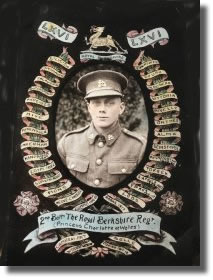
2nd Bn. Royal Bershire Regt.

LS02-2
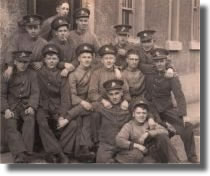
LS02-5
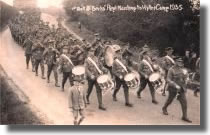
LS04-1
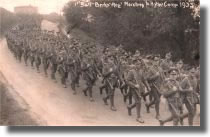
LS04-4
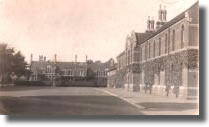
LS06-1
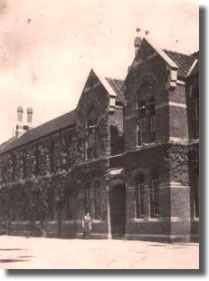
LS06-3

LS06-2
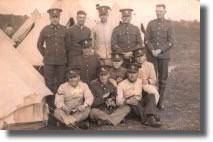
LS08-2
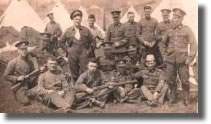
LS08-3
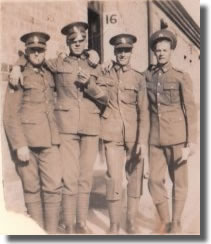
LS16-4

LS16-1
